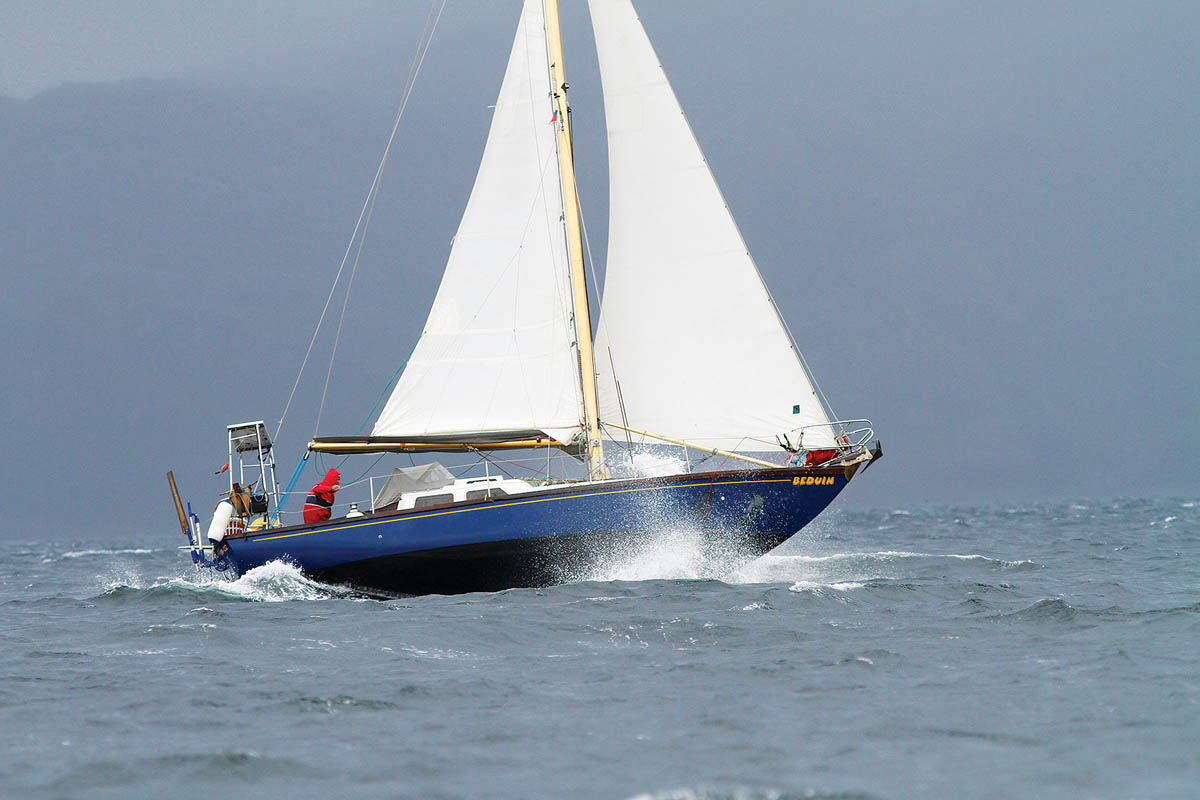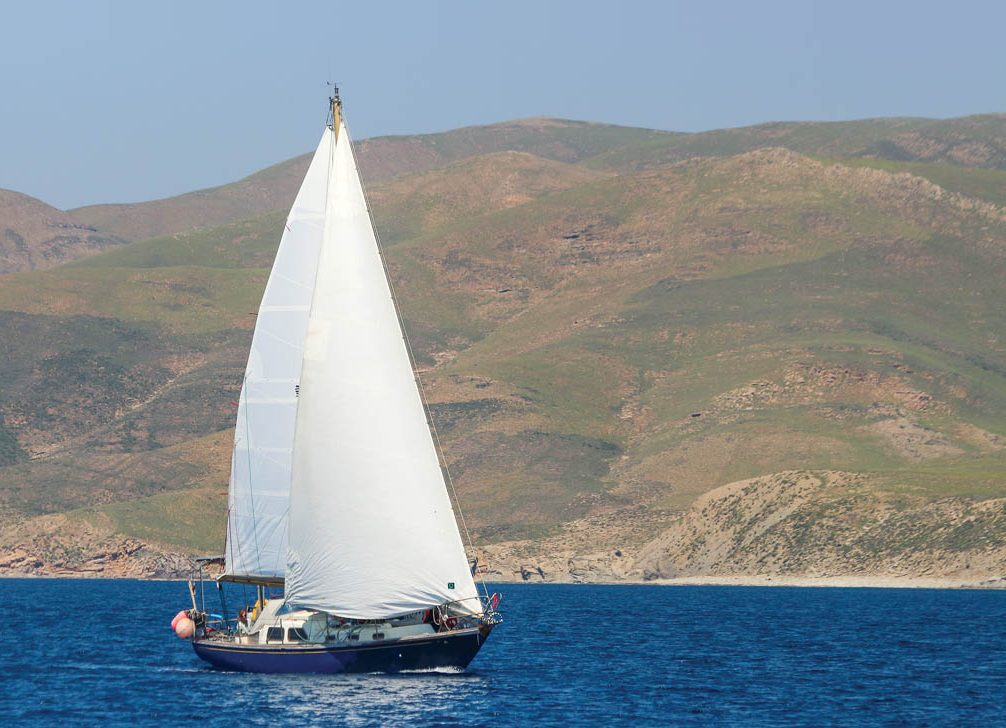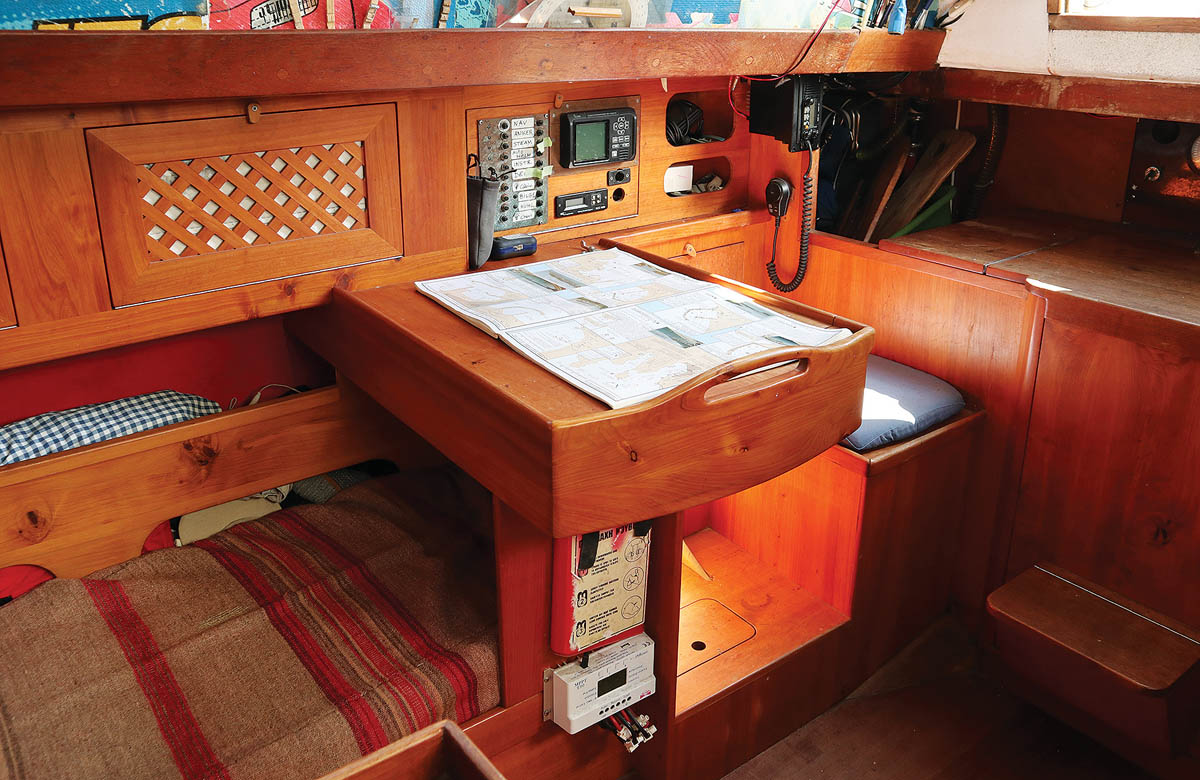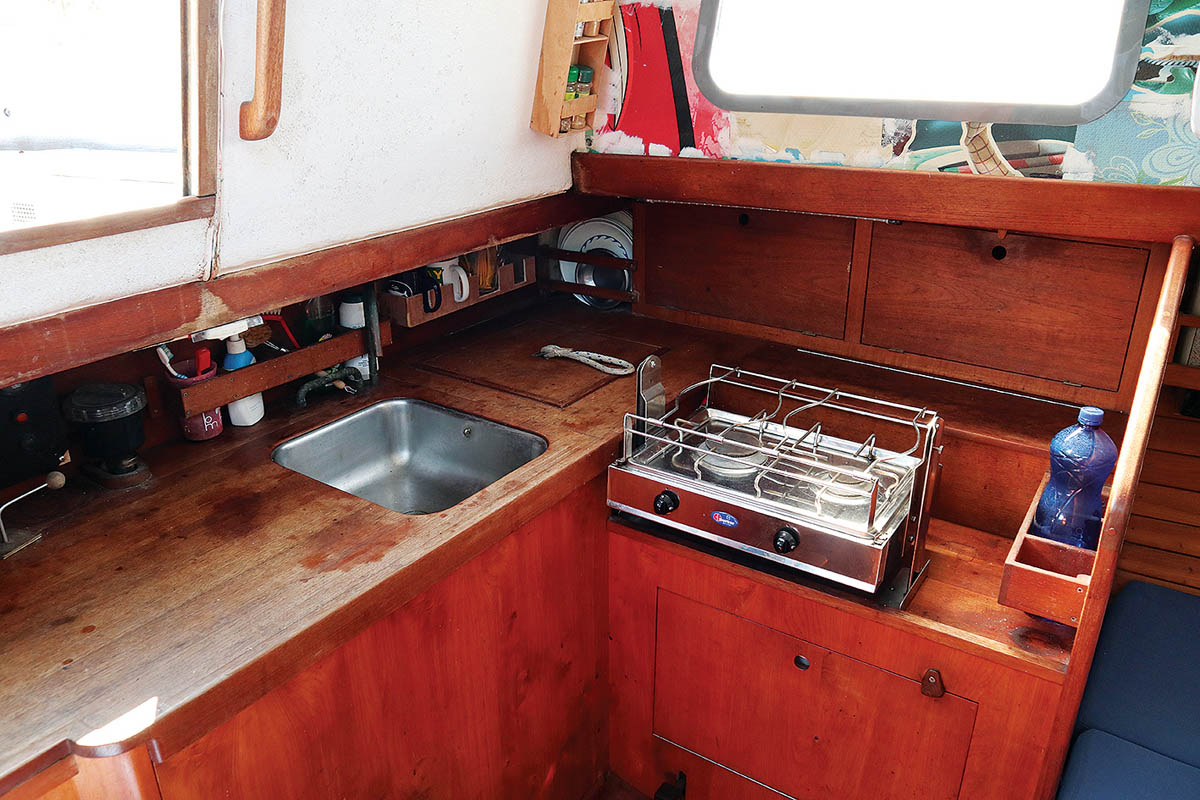Rupert Holmes test sails the Nicholson 32, one of the most desirable early glassfibre yachts and still a great second-hand buy
The Nicholson 32 was one of the first production-built GRP yachts of its size. It quickly gained a reputation for being an ultimate go-anywhere cruiser that was also fitted out to a high standard. Some 370 were built over an 18-year period, following the launch of the prototype in 1963, and examples have ventured to all parts of the globe.
Well known boats include Claire Francis’s Gulliver G, a 1966 model in which she completed her first solo Atlantic crossing in 1973.
More recently, Tony Curphey briefly became the oldest person to complete a non-stop circumnavigation via the Southern Ocean on board Nicola Deux when he completed the Longue Route last year.
Profile: Tony Curphey – 77,600 miles and still going strong!
At the same time, many Nic 32s have been used as excellent family cruisers.
Nicholson 32 – multiple versions and updates
The boat was the result of a partnership between pioneering glassfibre moulding company Halmatic and the Camper & Nicholson design office and shipyard. It was designed by Charles A Nicholson and his son Peter, whose family had an enviable reputation for yacht design, including America’s Cup challengers Shamrock and Endeavour, plus a long string of desirable custom ocean racing and cruising yachts.
Very heavy displacement was married to a high ballast ratio, slender beam and ‘a cod’s head and mackerel tail’ hull form. This shape, with full forward sections and relatively slender aft, had long been believed by British designers to produce a fast and sea kindly hull. And it creates more forecabin space than might be expected given the Nic 32’s relatively narrow overall beam.
In the early 1960s no one knew how strong glassfibre boats needed to be and construction is of massively thick chopped strand mat. It’s a crude construction by today’s standards, but benefits from being strong and easily repaired.
Part of the reason for the boat’s long-standing sales success was a constant stream of improvements, modifications and updates, with new versions launched for almost every London boat show during the 1960s.
Most of these new models reflected a large number of small changes and it was not until the advent of the MkX in 1972 that the boat was substantially changed. This version has an additional three inches of freeboard, the hull length increased to 33ft, and a more streamlined deck moulding. The result was a more modern looking boat, with additional space and a much higher standard of fit out than the earliest boats.
Our test boat Beduin is an extensively restored and upgraded 1964 example that has been owned by Aleko Stephan for more than 30 years. Before that she was his father’s boat, who bought her in 1981 when living in Belgium while Greece was ruled by a military junta. She was then sailed with the family through the European canals to the Gulf of Volos, in the north-west Aegean. The boat has been based there since 1982, but has cruised extensively.
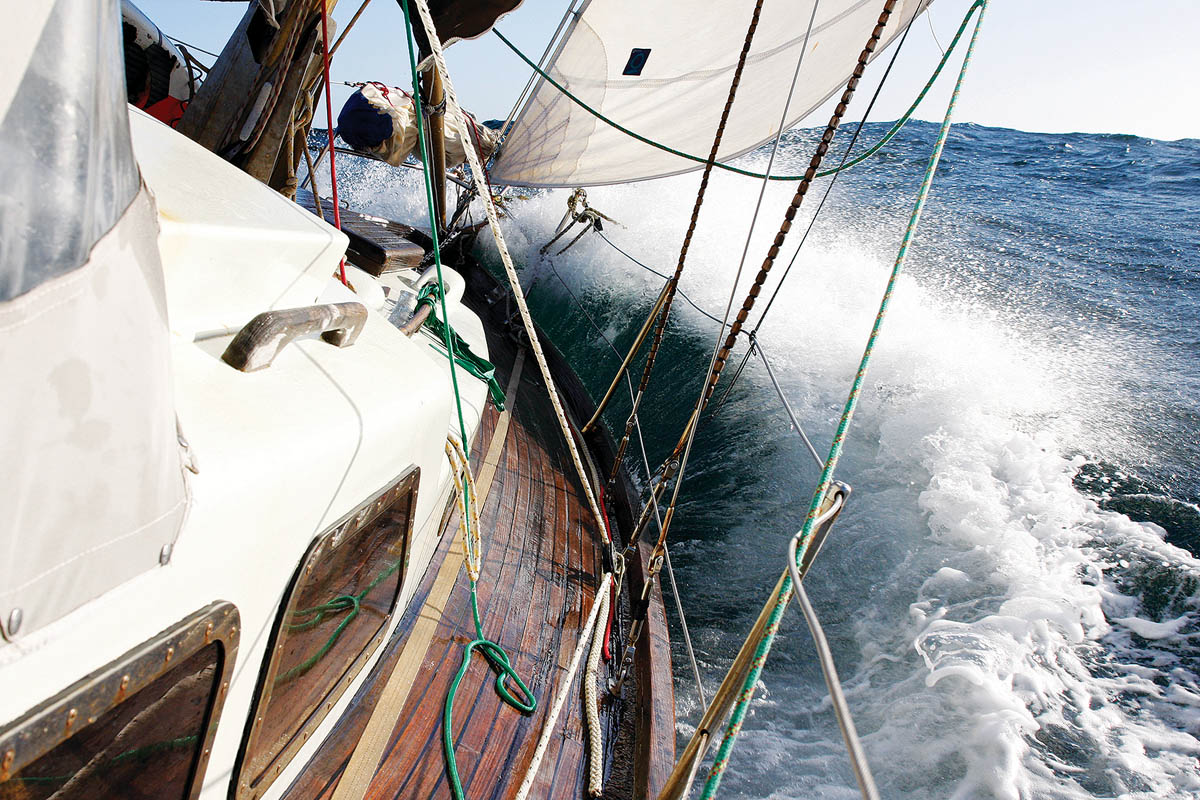
Nicholson 32 Beduin in the Falklands: Nicholson 32s have a reputation for being solid, go-anywhere cruisers. Photo: Genevieve Leaper
Beduin proudly wears battle scars accumulated in 26,000 miles of mostly single-handed sailing from Greece to the Pacific ocean, out via the Magellan Straits and back via the Beagle Channel and Falkland Islands, in 2015 to 2017.
It should be no surprise that such a well used boat of this age has had many refits.
In 2010-11 Aleko stripped the interior bare, even removing bulkheads and bunk fronts, before rebuilding the accommodation to a more open layout that better suits his needs.
Early Nicholson 32s were prone to osmosis and Beduin was no exception. When he first owned the boat she had already be suffering for several years, so he carried out an epoxy job himself, but now admits he didn’t fully understand what was necessary at the time. As a result the repairs failed some 12 years later, with water making its way right through the laminate in places.
The resulting rebuild, for which Aleko worked with friend and glassfibre specialist, Tim Preddy, saw more material ground away from the hull. It was then relaminated locally, before the entire lower part of the hull, from well above the waterline to the bottom of the keel, was wrapped in several layers of epoxy and woven glassfibre cloth.
Finally, they painstakingly faired the hull and repainted it.
Accommodation
Although the accommodation is very traditional in terms of layout, the big windows of the early Nicholson 32 models allow plenty of natural light in to the saloon. Later boats have smaller side windows but retain plenty of natural light, partly thanks to additional windows in the front of the coachroof, both in the saloon and in the forecabin.
Early boats had a relatively basic interior fit out, although the latest models were much improved. These had a very high standard of joinery in teak faced ply with solid cappings. Stowage on these boats was excellent, including plenty of smaller easy to access compartments.
The saloon of early boats had two settees, with a pilot berth outboard of one of them. However, this arrangement emphasised the boat’s narrow beam of only 9ft 3in.
By the late 1960s the layout changed to a single settee, plus a dinette arrangement opposite that could be converted to a second double berth.
Later on, the standard model reverted back to conventional settees, but these were pushed out further towards the sides of the hull, to create a greater feeling of space.
Mark XI boats, from 1977 onwards, had a glassfibre inner moulding that finished at the top of the bunks. This has generally worn well, even on boats that have had a period of poor maintenance, and also gives plenty of dry stowage.
On all models there’s space in the bilge for water and fuel tanks, which frees up space under the bunks for other items.
Right from the outset the full-width heads compartment between the saloon and forecabin was intended to be well appointed, with much use made of easily cleaned glassfibre mouldings. The level of fit-out here also improved with later versions, particularly the MkX and MkXI.
The full bow sections mean foot room for the forecabin’s double V-berths is far greater than that of most yachts of this size. With their extra freeboard, and the coachroof extending further forward, the MkX and MkXI have even more space here.
On the downside, in order to improve performance by keeping weight out of the bow, a lot of Nicholson 32s originally had the hawse pipe for the anchor chain led between the two forepeak berths. Not surprisingly many owners have found a way to re-route it.
Beduin now benefits from a complete interior overhaul. Aleko is a woodworker with an artist’s eye and stripped everything back to the bare hull ten years ago, replacing it with a more up-to-date layout. He used teak for the floor, galley and table, and cypress from a tree his father planted for the rest of the woodwork.
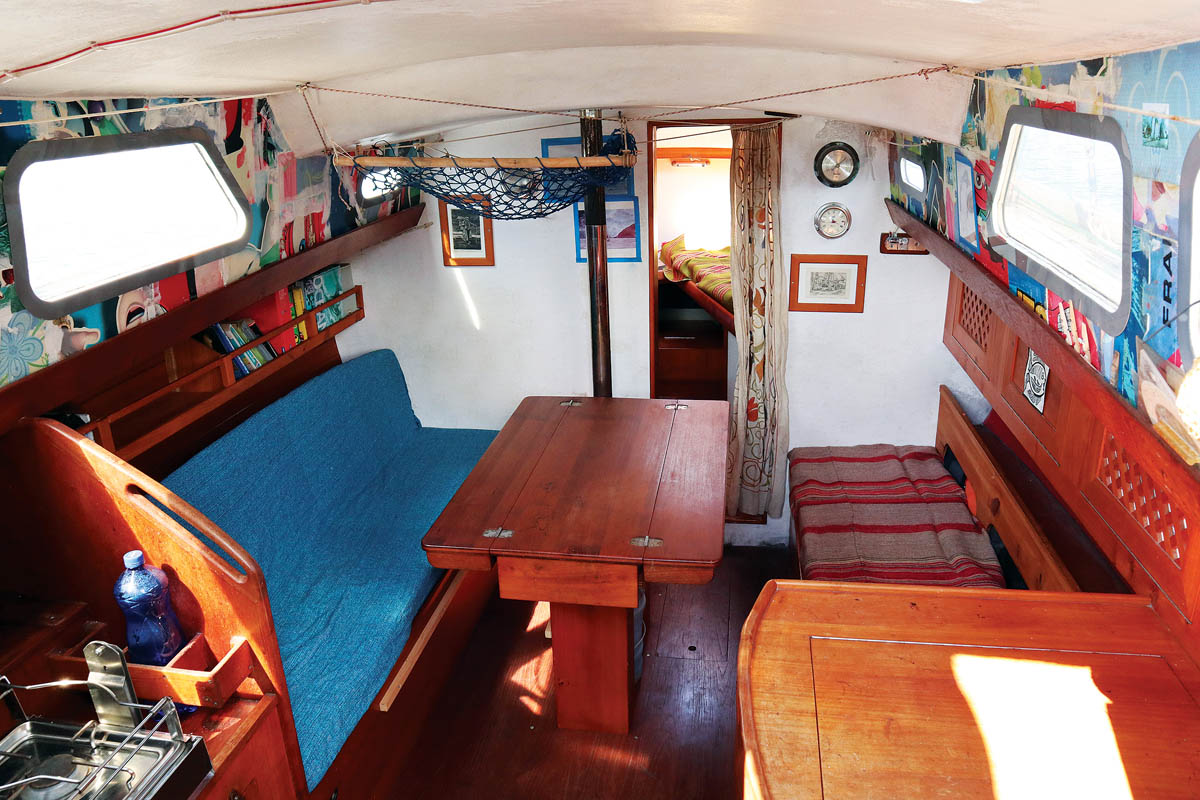
Pushing the settees out towards the side of the hull created a feeling of space. Photo: Genevieve Leaper
As with the later boats, the settees are now further outboard, with the port one designed to pull out into a double. He also reconfigured the navigation station and chart table areas next to the companionway.
The accommodation forward of the mast has been truncated, to allow space for a big foredeck locker with two hatches in which to stow hank-on headsails.
On deck
The long and narrow cockpit has safe space for several crew to sit on benches each side, plus a more open area right aft. MkX and MkXI boats have a longer cockpit, but no aft deck. Cockpit stowage includes lockers under both side benches, plus a large lazarette aft.
Despite the boat’s narrow beam, side decks of both versions are of a decent width. Going forward from the cockpit is therefore easy, especially as deep bulwarks add to the sense of security and the coachroof mounted grab rails fall easily to hand.
Originally halyards and other lines were handled at the mast. This is still the case with Beduin, although some owners have led key controls back to the cockpit. The broader forward sections provide plenty of space on the foredeck. Different versions had different arrangements for anchor handling, including some with a foredeck locker shaped to fit the anchor, in addition to a chain locker.
The single-spreader masthead rig is well supported. Beduin’s mast is deck stepped in a tabernacle, although some Nicholson 32s have keel-stepped spars.
Aleko has upgraded the original winches to modern Andersen units, including self-tailing primaries.
Under sail
This is an area in which the Nicholson 32 has always been considered to excel. Of course, over the past 60 years boat design has taken huge strides forward and new models can be significantly faster. However, few are as well proven at sea as this boat.
When passage planning for ocean crossings Aleko estimated on 120 miles per day – equivalent to an average of five knots – but could easily exceed that figure on a good day.
A comfortable motion, even in confused seas, is a positive feature of the design that is certainly not shared with many newer yachts.
On the downside, in common with other relatively narrow boats, the Nicholson 32 can have a tendency to roll downwind more than you would find on board modern yachts with a broad transom. The heavy displacement can also make for a wet ride, so a sprayhood is essential when close-hauled in a blow.
The keel-hung rudder has no balance area, so the helm is heavier than that of a fin-and-skeg or spade rudder, but the boat is still small enough to be easy to manage with tiller steering. Optional wheel steering was introduced with the MkXI version in 1977, but this was more of a fashion accessory than a necessity.
In addition to the directional stability conferred by the length of the keel, the rudder’s lack of balance area helps to keep the boat on course. The helm can therefore be left for short periods of time, especially with the wind forward of the beam, without the boat wandering dangerously off course.
The long keel and hefty displacement might suggest slow progress to windward, but experience suggests otherwise and locally Beduin has a reputation for being a very fast boat in all conditions.
Pilot guides for the Patagonian canals say it’s impossible to make acceptable ground against the winds and currents there. Yet, when the freshwater cooling pump of Beduin’s engine packed up, Aleko was able to continue under sail by finding back eddies and then short tacking up the narrow ‘rivers’ of favourable stream.
Trying to squeeze up super close to the wind when close-hauled will never deliver good results in a long-keel boat. However, Beduin reliably tacks though a very respectable 90°, measured using the track on a chartplotter. Boat speed upwind is typically 5 to 6 knots in a range of wind strengths, depending on sea state, and Beduin can hold on to her full sail plan in winds of up to Force 5.
Bearing away onto a reach the boat can maintain average speeds of around 6.5 knots.
What about in very strong winds? Clearly Nicholson 32s are very capable boats in this respect, and Tony Curphey certainly experienced extreme conditions in the Southern Ocean during his circumnavigation.
Beduin doesn’t have wind instruments, so Aleko doesn’t know for sure the strongest winds he experienced on his trip to South America, but says: “I can only guess according to the height of waves, the flying spray and a wish to have ear plugs, but I would estimate Force 10 Beaufort.”
However, it must be remembered that no small boat is invincible. Golden Globe Race competitor Loïc LePage, for instance, lost the rig of his Nicholson 32 Laaland 600 miles off the coast of Australia. With the rig having punched a hole in the boat, he was forced to abandon her.
Under power
Given the long production run, it’s hardly surprising that a variety of engines were fitted when the boats were new. Most of these have been replaced with newer units, in Beduin’s case, a powerful 4-cylinder marinised 27hp Kubota engine. However, I also know of boats that have successfully been repowered with engines as small as the 18hp Yanmar 2GMF.
Handling under power is arguably is the Nicholson 32’s biggest weakness – the long keel and relatively small rudder makes for a large turning circle, while water flow over the keel stalls at a higher speed than modern yachts with keels of a more efficient aerofoil shape.
In reverse there’s lots of prop walk and the rudder shape means steerage way in reverse is only gained at relatively high speeds. Having said that, handling is predictable and can therefore always be allowed for when planning manoeuvres.
Verdict
The Nicholson 32 dates from a different era, one in which 32ft was seen as being a largish yacht. Today there are clearly boats of this size that offer a lot more accommodation volume and are easier to squeeze into tight marina berths.
But the Nicholson 32 stands out from the crowd thanks to its well proven sea keeping qualities, classic lines, robust hull shape/keel configuration and high quality of original fit out.
There are few boats in this price range that so demonstrably offer the potential for go-anywhere passage making. These abilities are also just as relevant for those looking for a tough cruiser for less ambitious sailing.
SPECIFICATIONS
LOA: 9.7m / 32ft 0in
LWL: 7.31m / 24ft 0in
Beam: 2.80m / 9ft 3in
Draught: 1.60m / 5ft 6in
Displacement: 6,100kg / 13,450lb
Ballast: 3,000kg / 6,615lb
Sail area: 55sq m / 594sq ft
Price: £9,000-£22,000
www.nicholson32.org
Originally published in Practical Boat Owner magazine: Summer 2020





